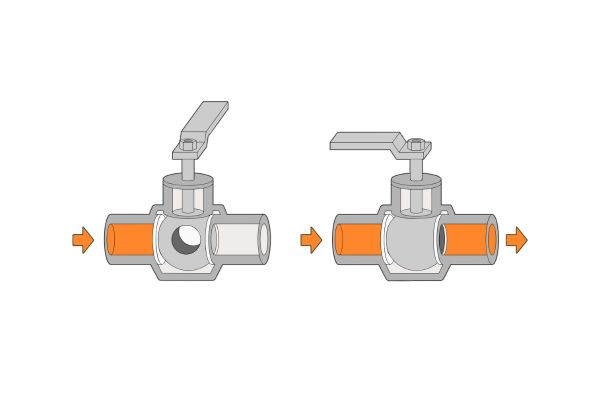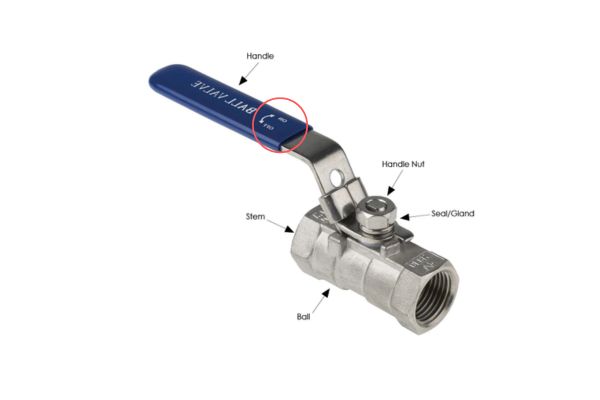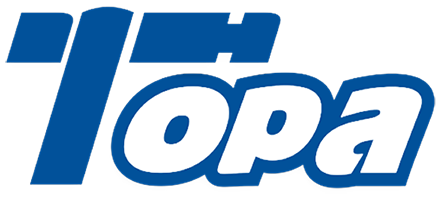A ball valve is a mechanical device used to control the flow of liquids and gases through a pipe. It consists of a spherical ball with a hole (or port) through the middle, which rotates to open or close the valve. The ball is connected to a stem, which is operated manually or automatically to rotate the ball. Ball valves are commonly used in systems that require quick shut-off.
How Ball Valves Work
The Inner Mechanics of a Ball Valve
Ball Valve Construction: A ball valve consists of a spherical ball, which has a hole or port in the center, placed inside a valve body. The ball is housed within a chamber and is connected to a stem that is used to rotate the ball.
Operation Principle: The valve opens and closes by rotating the ball to align or misalign the port with the flow path. When the port aligns with the pipe, the valve is open, and when the port is perpendicular to the flow path, the valve is closed.
Sealing Mechanism: Ball valves use resilient seals, usually made from materials like Teflon or rubber, around the ball to ensure a leak-tight seal when the valve is in the closed position. This prevents fluid or gas from escaping and ensures safe operation in high-pressure systems.
Flow Control: Ball valves are designed for on/off control but can also be used for throttling purposes, depending on the valve’s design. Some ball valves are designed to control the flow rate through an adjustable orifice within the ball.
How the Valve Stem and Handle Control Flow
Valve Stem Function: The valve stem is attached to the ball and serves as the mechanism through which the valve is opened and closed. It transfers motion from the external handle or actuator to the ball inside the valve.
Manual Control with the Handle: In a manual ball valve, turning the handle clockwise or counterclockwise rotates the stem and ball. The position of the handle indicates whether the valve is open or closed.
Open Position: The handle is typically parallel to the pipe, signaling that the ball’s hole aligns with the flow path, allowing fluid or gas to pass through.
Closed Position: When the handle is perpendicular to the pipe, the ball’s hole is rotated away from the flow path, shutting off the flow.
Handle Locking Mechanism: Some ball valves come with a locking mechanism or a detent, which helps to secure the valve in the open or closed position, ensuring there’s no accidental movement.

Different Types of Ball Valves: Manual vs Automated
Manual Ball Valves:
Manual ball valves are controlled by a handle that requires human intervention to operate. These are typically used in smaller systems or where infrequent valve adjustments are necessary.
Advantages: Simple operation, low cost, and reliability for basic on/off control.
Disadvantages: Requires manual effort and may not be suitable for systems where frequent adjustments or remote control are needed.
Automated Ball Valves:
Automated or motorized ball valves are designed for remote operation. These valves use electric, pneumatic, or hydraulic actuators to rotate the valve’s stem and control the ball’s position.
Electric Actuators: Controlled by electrical signals, often through a control panel or automation system. Suitable for applications requiring precise, repeatable positioning.
Pneumatic Actuators: Use air pressure to operate the valve, ideal for high-speed operation and applications in hazardous or explosive environments.
Hydraulic Actuators: Use fluid pressure to operate, often found in heavy-duty applications where high torque is required to open or close the valve.
Advantages of Automation: Easier integration into modern control systems, improved precision, and the ability to monitor and adjust valve operation remotely.
Disadvantages of Automation: Higher upfront costs, maintenance complexity, and the potential need for a power source, especially in remote locations.
The Key to Identifying Valve Position: Valve Handle Position
Why the Valve Handle Position Matters
Clear Indicator of Valve Status: The position of the valve handle provides a quick, visual cue to indicate whether the valve is open, closed, or partially open. This helps operators quickly assess the flow status of a system without needing additional tools or complicated procedures.
Preventing Flow Interruptions: A properly aligned handle prevents accidental misoperation, ensuring that the valve operates in the intended manner. Misalignment can result in fluid or gas flow disruptions, leaks, or even system failures.
Consistency in Operations: Consistent handle position across all valves in a system allows workers to efficiently control and monitor valve states, reducing the risk of human error. Whether the system uses manual or automated valves, handle position is a universally recognized marker.
Safety Considerations: The handle’s position is essential for maintaining system safety. For instance, if a valve is in the wrong position (e.g., partially open when it should be closed), it can lead to dangerous pressure buildups, leaks, or even explosions, depending on the application.
The Role of the Valve Handle in Indicating Open or Closed Status
Visual Positioning: The handle’s alignment relative to the valve body provides an immediate visual cue. In most systems, the valve handle will be aligned parallel to the pipe when open and perpendicular when closed. This simple positioning allows for fast identification.
Open Position: When the handle is parallel to the pipe or flow direction, the ball valve’s port is aligned with the pipe, allowing fluid or gas to flow through the valve.
Closed Position: When the handle is turned perpendicular to the pipe, the ball’s port is rotated out of alignment with the pipe, blocking the flow of fluid or gas.
Handle Position Markings: Some ball valves have markings or labels near the handle that clearly indicate “OPEN” or “CLOSED” for added clarity. These markings can be especially helpful in larger systems or where multiple valves are present.
Partial Open/Throttling: In some cases, the handle may not be fully open or closed but positioned somewhere between. This intermediate position is commonly used for throttling or controlling the flow rate, particularly in larger systems. However, for safety and ease of use, this should be clearly marked on the valve.

How to Align the Handle with Flow Direction
Understanding Flow Direction: To properly align the handle with the flow direction, you first need to understand the system’s flow. In most cases, the handle is positioned to align with the flow path when open.
Open Valve Alignment: When the handle is aligned with the flow, it ensures that the port in the ball valve is in line with the pipe, allowing fluid to pass through unimpeded. This is typically achieved by rotating the handle until it is parallel to the pipeline.
Closed Valve Alignment: To close the valve, you rotate the handle so that it is perpendicular to the pipe, which rotates the ball and stops the fluid flow.
Handling Reverse Flow Systems: In some systems, fluid may flow in reverse or the valve may need to be configured for bidirectional flow. In such cases, ensure that the valve handle is aligned according to the intended flow direction, as reverse flow can sometimes change how the valve responds.
Indicators for Alignment: Many modern ball valves come with built-in indicators (such as a line or arrow) on the handle or body, which show the correct orientation for open and closed positions. These visual guides help ensure correct valve operation, reducing the likelihood of human error in complex systems.
Using Valve Markings to Confirm Direction: Look for additional markings or tags on the valve itself, such as “IN” and “OUT” for inlet and outlet flow directions, to assist in correctly aligning the valve handle. If the valve is part of a larger, automated system, the actuator might also include directional indicators for precise control.
How to Tell If Ball Valve Is Open or Closed
Step-by-Step Process for Checking Valve Position
Locate the Valve Handle: The first step is to identify the valve handle, which is usually the easiest indicator of the valve’s position.
Check the Handle Orientation:
Open Valve: If the valve is open, the handle will typically be aligned parallel to the pipe or flow direction. This indicates that the ball’s hole is in line with the pipe, allowing fluid to flow.
Closed Valve: If the valve is closed, the handle will generally be positioned perpendicular to the pipe. This means the ball’s hole is rotated out of alignment with the pipe, blocking the flow.
Turn the Handle (If Necessary): If you are unsure, try gently rotating the handle. If it moves without resistance, the valve is likely to open. If the handle is stiff or difficult to turn, the valve is probably closed or obstructed.
Confirm the Position: For valves with specific flow direction indicators, such as arrows or markings, confirm that the handle is in the correct orientation according to the flow path.
Visual Indicators of Open vs Closed Ball Valve
Handle Position: As mentioned, the most common visual cue is the position of the handle.
Open Valve: Handle is parallel to the pipe or flow direction.
Closed Valve: Handle is perpendicular to the pipe.
Valve Color or Markings: Some valves have color-coded handles (e.g., red for closed, green for open) or markings near the handle to indicate the position.
Valve Body or Cap: For larger ball valves, there may be visible indicators, such as markings or labels, directly on the body of the valve to help identify its open or closed state.
Ball Position: In some designs, you can visually inspect the ball itself through small inspection windows on the valve body. If the ball is rotated, it means the valve is either open or closed, depending on the orientation.
The Importance of Checking Valve Markings
Clear Identification: Markings on the valve body, handle, or stem can provide clear, concise indicators of valve position, helping to avoid confusion or mistakes.
Flow Direction: Some ball valves include directional flow arrows to indicate the correct orientation for proper function. This is particularly useful in multi-valve systems or where the flow direction might change.
Safety and Efficiency: For proper operation, especially in high-pressure or critical applications, checking the markings ensures that valves are not only open or closed but also set up to handle flow in the desired direction. Incorrect positioning due to missed markings can lead to leaks, pressure issues, or equipment damage.
Preventing Errors in Maintenance or Repairs: When performing maintenance, repairs, or troubleshooting, the markings provide a quick and reliable reference for correctly assessing the valve’s function and position.
Understanding the Relationship Between Valve Position and Fluid Flow
How an Open Ball Valve Affects Fluid Flow
Unrestricted Flow: When a ball valve is open, the ball’s hole or port aligns with the pipe, allowing fluid or gas to flow freely through the valve. This creates minimal resistance to the flow, making ball valves ideal for systems that require quick on/off control.
Fluid Passage: The open position of the ball valve allows for direct, uninterrupted fluid passage from the inlet to the outlet. Whether the fluid is a gas, liquid, or slurry, the flow is unrestricted, and the valve behaves like an open conduit.
Pressure Regulation: While the valve itself doesn’t regulate flow rate when fully open, it can affect system pressure. In applications with multiple valves, the ball valve can impact downstream pressure or create pressure differences due to its large flow capacity.
Efficiency in Flow Control: In large industrial systems, open ball valves offer a fast and efficient way to control flow, as their simple design minimizes friction and turbulence, ensuring high flow rates with low resistance.
What Happens When a Ball Valve is Closed?
Flow Blockage: When the ball valve is closed, the port of the ball is rotated 90 degrees, so it no longer aligns with the pipe’s flow path. This effectively blocks the passage of fluid or gas through the valve.
Complete Shutoff: In the closed position, the valve provides a complete shutoff, stopping the flow entirely. This feature is especially important in emergency shutdowns, where stopping fluid flow quickly is necessary to protect equipment, prevent leaks, or manage pressure.
Increased Pressure: In systems with closed valves, pressure may build up on the upstream side of the valve. If not managed correctly, this can lead to overpressure situations, leaks, or potential damage to pipes and equipment.
Energy Conservation: Closing the valve can also help conserve energy by stopping the flow of pressurized fluids that may be used for energy generation or other processes.
How to Tell If Ball Valve Is Open or Closed Based on Flow Direction
Flow Direction Markings: Many ball valves are marked with flow direction arrows on the valve body. These arrows indicate the intended direction of fluid flow. When the valve is open, the flow will follow this direction without interruption.
Open Valve: The handle will be aligned parallel to the flow direction, and fluid will pass through in the direction indicated by the arrows.
Closed Valve: When the valve is closed, the handle will be perpendicular to the pipe, and fluid will be blocked in the direction of flow.
Check for Pressure Build-Up: In some systems, you can tell if the ball valve is open or closed by checking for pressure differences on either side of the valve. A closed valve may result in a significant pressure build-up upstream, while an open valve will maintain relatively even pressure on both sides.
Fluid Movement Observation: In a flowing system, observing the movement of fluid or gas through the valve can provide additional confirmation. If there is a lack of flow or a sudden drop in flow velocity, it may indicate that the valve is closed.
Sound of Flow: The sound of fluid or gas passing through a valve is another clue. When the valve is open, the flow is usually smooth and consistent, while a closed valve will silence the flow, as no fluid is passing through.
Valve Markings and Symbols
Key Valve Markings to Look for During Inspections
Flow Direction Arrows: One of the most important markings, flow direction arrows indicate the proper direction for fluid or gas flow. These arrows are typically located on the valve body or near the valve handle and ensure that the valve is installed and operated correctly. Incorrect flow direction can lead to leaks, pressure buildup, or equipment failure.
Open and Closed Indicators: Many valves have clear markings indicating whether the valve is in the open or closed position. This can include text like “OPEN” and “CLOSED” or visual cues such as color-coded handles.
Pressure Rating Labels: These markings tell you the maximum pressure the valve can handle without failure. It’s essential to match the valve’s pressure rating to the requirements of the system to prevent overpressure situations that could result in leaks or damage.
Temperature Range: Some valves also have temperature markings, indicating the safe operating range for the valve. These are critical in systems where temperature extremes could affect valve performance or material integrity.
Material Identification: Valves often have markings that indicate the material used in their construction, such as “SS” for stainless steel or “CS” for carbon steel. This is especially important for ensuring compatibility with the fluid or gas being transported and avoiding corrosion or material degradation.
Valve Type Identification: Markings may also specify the type of valve, such as “Ball Valve”, “Check Valve”, or “Globe Valve”. This helps operators and maintenance personnel quickly identify the valve type during inspections and repairs.
Flow Coefficient (Cv): For some ball valves, there may be a Cv value marking, which indicates the flow capacity of the valve at a given pressure drop. This helps engineers calculate flow rates and ensure proper valve sizing for the system.
How to Read Valve Symbols for Position and Operation
Basic Valve Symbols: Valve symbols are part of a standardized system used to represent various valve types and functions in piping and instrumentation diagrams (P&ID). Understanding these symbols can help in interpreting system schematics and recognizing the valve’s role in the larger process.
Ball Valve Symbol: The symbol for a ball valve typically consists of a circle with a solid or hollow center (representing the ball) and lines indicating the flow direction. The solid ball represents a closed valve, while the hollow circle represents an open valve.
Gate Valve Symbol: A line across a circle indicates a gate valve, which is typically used for full-on/full-off flow control.
Globe Valve Symbol: Represented by a circle with a zigzag line, a globe valve is used for regulating flow rather than just stopping or starting it.
Positioning Symbols: Some valve symbols include arrows or marks to indicate whether the valve is open or closed. A ball valve symbol with a diagonal line or hash marks typically indicates a closed position, while a clear, open circle indicates that the valve is fully open.
Actuation Symbols: In systems with automated valves, you may see symbols that represent the actuator type. For instance, an electric actuator will be marked with a symbol indicating electrical components, while a pneumatic actuator might include an air symbol to denote air pressure control.
Fail-Safe or Fail-Closed Symbols: For automated systems, symbols may indicate whether a valve is designed to fail open or fail closed in case of a malfunction. This is important for ensuring safety in critical applications, such as gas lines or hazardous material transport.
Throttling Symbols: Some ball valves or control valves are designed for throttling, meaning they can adjust the flow rate. These symbols may show a ball with multiple ports or an extra line to indicate that the valve can be adjusted for partial flow control.
Conclusion
Understanding whether a ball valve is open or closed is essential for maintaining efficient and safe fluid or gas flow. To determine its position, simply check the handle orientation: when the valve is open, the handle will be parallel to the pipe, allowing fluid to flow, while in the closed position, the handle will be perpendicular to the pipe, blocking flow.
FAQ
How can I tell if my ball valve is open or closed?
The simplest way is to check the valve handle. If the handle is parallel to the pipe, the valve is open; if it’s perpendicular, the valve is closed.
What do the markings on a ball valve mean?
Markings on the valve, such as arrows, indicate the correct flow direction, while “OPEN” and “CLOSED” markings help you determine the valve’s position.
Can I check a ball valve’s position just by feeling the handle?
Yes, gently turning the handle can provide clues. If it moves smoothly with little resistance, the valve is likely open; if it’s stiff, the valve may be closed or partially obstructed.
Why does the position of a ball valve matter?
The position determines whether fluid or gas flows through the pipe. An open valve allows flow, while a closed valve stops it, ensuring proper system operation and preventing leaks.
How often should I inspect my ball valve?
Regular inspections are recommended to check for leaks, proper operation, and wear. Depending on the application, aim for inspections every 6–12 months.
What can affect a ball valve’s performance?
Factors like corrosion, debris buildup, high system pressure, or improper installation can all affect the valve’s performance, leading to leaks or failures. Regular maintenance can help prevent these issues.







